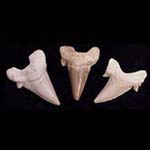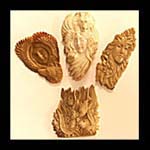Have you ever wondered how your beaded bracelet came about? What about the earrings and the beaded necklace that look so elegant together? Our favorite craft has been around for thousands of years. Beading and jewelry design is a significant find at an archeological dig site. Beads can determine how a society functioned. Beads have had religious significance. Beads have been worn by hunters. Beads have declared status. Beads have shown us how our ancestors expressed themselves and how they valued art.
In 2003, archaeologists working for Serengeti Genesis, a non-profit research organization, discovered what may be the earliest beads ever found. Working at an open-air site in Loiyangalani River Valley, in Serengeti National Park in Tanzania, archaeologists unearthed ochre pencils, carved bones, tools, and ostrich egg beads.

Finding beads at older excavations like this is important. Beads are among the items archeologists look for when trying to determine "behavioral modernity". Behavioral modernity is a term referring to the point when early man started to express creative thought and started to establish a cultural identity.
The ostrich egg beads were found buried with items and under sediment that dates them somewhere in the African Middle Stone Age which began as early as 280,000 years ago and concluded with the Later Stone Age, around 45,000 years ago. The find is significant. Until this point, the ability to think abstractly and create art was believed to have originated around 35,000 years ago. Although these beads have not been positively dated yet, they may indicate that symbolic thought began much earlier. The ostrich egg beads were around 5mm in diameter. They were probably created by breaking an ostrich egg in small pieces, drilling a center and smoothing and rounding the bead channel. They may have been strung on fiber or sinew.

Early beads may have been many things: Adornment and art. Trade between different groups of hunter-gatherers. They may also have been used to signify belonging to a group. Another early site was discovered in France. Beads excavated from La Quina were estimated to have originated around 38,000 B.C. These beads were grooved and made from animal teeth and bones. They were likely worn as pendants.
A French site known for its wealth of ancient beads is Grotte du Renne. The Grotte du Renne is a cave that was used a shelter for Stone Age man. Artifacts found inside include teeth from foxes, bears, reindeer, hyenas, and marmots. The teeth are grooved and ready to be hung from a necklace. Also inside the cave was a fossilized crinoid stem. Crinoids, also known as "sea lilies" are marine animals that have a mouth on the top surface and are anchored to a substrate with a stem. The stems can have natural holes, but many early crinoid stems have holes that were grooved and readied for wear.

The Chatelperronian period, around 31,000 B.C. was the point when beads started to become abundant as an art form of man. It was from this point forward when large caches of beads would be found in excavations. Prior to this, only a couple of beads might be found at any site.
Bead craftsmanship took a giant leap forward around 30,000 - 18,000 B.C. during the Gravettian and Aurignacian cultures. As tools became more sophisticated, the practice of bead making became much more refined. Where beads had once been grooved, the channels were now created by perforation. Bone and ivory beads were now being created through grinding processes. An important find from this era was discovered in 1986 near a village called Dolni Vestonice in the Czech Republic. It was here that a series of sites were uncovered. The sites were used by mammoth hunters. Amongst the finds were necklaces made from mammoth ivory, the ivory was perforated and etched. Other necklaces were made from shell and arctic fox teeth. Perhaps the most stunning object was a small nude female figurine. The statuette, known as the Venus of Dolni Vestonice is the oldest known ceramic in the world.
Beads from this period may have served many purposes. Other than artistic adornment, they may have taken on an elevated status. Beads may have been worn as talismans to protect the hunters from danger. They may have also become items of power. If a tooth was removed from a kill and then worn, that object might have been assumed to contain some of the animal's energy and allowed the wearer of that bead to gain strength from that animal.

Tools were no longer just being created for hunting, killing, and cleaning. Tools were now being created to make it easier to design other tools and for artistic endeavors. A chisel called the Burin was especially important in that it made it easier to etch, cut and shape beads. The complexities of bead designs were much more detailed at this point.
The end was nearing for nomadic man. The twilight of the hunter-gather saw advances in cave paintings, sculptures, sewing, and the domestication of the dog. Bead stringing become more elaborate and refined. The nomads, accustomed to following the hunt for sustenance and life would soon be learning how to produce food. Once the nomads started to become settlers, they would start accruing material goods. As settlers, they would no longer commit all of their time to hunting and surviving. Artistic craft could now be refined.
The Neolithic period heralded the end of the Stone Age. Neolithic Man began establishing villages and focusing on outlets for food gathering such as fishing and farming. Neolithic houses were built with stone. Possessing and collecting material goods was now possible. Beading flourished, lavished on the dead and sent into the service of religion, it had expanded beyond the simple adornment and art of Ostrich Beads. Trade routes opened and shell and coral beads moved from the coast into the main lands.
Visit the Soft Flex Company YouTube Channel!
Blog contributor Thomas Soles is the Trade Show Coordinator for Soft Flex Company. His favorite stones are Lapis and Pietersite. His favorite hobby is day dreaming. And his favorite mustache is Tom Selleck's. As you can see, he has a healthy (or possibly unhealthy) sense of humor. You can write to him at Thomas@SoftFlexCompany.com




